| |
M114 - The Armored Jeep
I recall an
illustration from either Popular Science or Popular Mechanics in the
early 1960s that featured, spanning both pages, a vivid battle scene
with Soviet tanks and infantry carriers attacking out of the morning
mists in Germany. Done in comic book style, the battle raged in the
center of the painting, cannon fire, explosions, flashes of bright red
and yellow against dark purple and deep blue backgrounds. As expected,
nuclear mushroom clouds dominated the distant horizon.
Then, to take the viewer to a more detailed
view of the battle, lines radiated out from the central combat to a
series of panels on the sides of the pages showing much more detailed
views of the battle annotated with captions. The overall title of the
article was along the lines of "New Technical Weapons Give US
Soldiers Big Advantage if War Breaks Out" and the close up panels
seemed ¼ active weapons development, ¼ feasibility projects and ½ US
Army meets Tom Swift dream book.
|
|
|
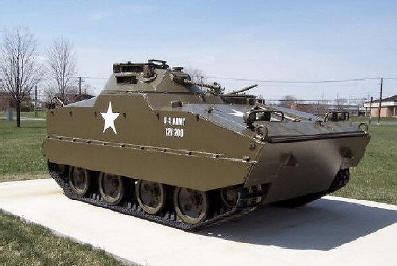 |
|
Early M114
prototype --Tencza |
|
|
One panel featured robot loaders shown in a
cut-away 155 mm howitzer turret. The caption in part ... robotic
loaders and drivers add to artillery power ...", in another panel,
infantrymen with individual jet packs were firing as they leap-frogged
over astounded Soviet troops. The next panel displayed a small tracked
vehicle; turretless, it looked like an infantry carrier but reduced in
size by 1/3, hiding in a wood line with the commander making a spot
report on an unsuspecting Russian column. The caption, "... using the
new M114 reconnaissance vehicle, scouts locate the enemy advance and
...", in the next lower panel ... the robots have a nuclear cannon
shell enroute to the Soviet horde. Needless to say, I was impressed!
Interestingly, while the US Army of that era
did have active prototype programs for jet packs and one man
helicopters and even in today’s budget, programs still fund robotic
driver and loader tests, one of the few concepts shown that made it
off the artist’s easel and magazine page and into the active Army
inventory was the M114 Command and Reconnaissance Vehicle.
It was the only scout specific vehicle
developed, tested, funded and widely issued to the active Army in the
sixteen year period between the end of World War II until the early
1960s. In many ways, it presaged the M551 Sheridan in both design and
fate. The Airborne Command and Reconnaissance Vehicle was built to be
fast, stealthy, swim capable and deployable by parachute. It was a
blank sheet project integrating new materials and concepts that
spanned the designer’s table, the manufacturing floor and Army
hardstands in Germany. Prototype and manufacturing milestones were
set, then met. The US Army monitored each step and umpired the final
acceptance trials. An experienced major corporation managed the
program from design to first production vehicle, to final copy off the
assemble line. It was an interesting design and a marginal performer
with trooper recollections running from "death trap" to "an acceptable
performer" .
Thousands were built, about forty were sent to
Vietnam where the problems mounted and they were parked and locked. In
service in Germany some technical problems were solved but, by trying
to retrofit the scout vehicle into a fighting vehicle, old chronic
problems mounted. This interesting vehicle was a product of the
Cleveland Tank Plant, it was with the 14th Cavalry at Daley Barracks
for some ten years with apparently the last ones turned in during the
early years of the Eaglehorse in Germany. It was the M114.
|
|
|
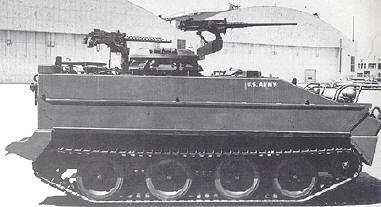 |
|
Scouts Out!! An
early production model M114 ready to roll. The armored jeep was
supposed to provide speed, maneuverability and protection to the
Army scouts of the early 1960s. --Hunnicutt |
|
|
To tell the story of the first scout vehicle
of the modern Army era, we rely on R. P. Hunnicutt’s excellent,
Bradley-A History of American Fighting and Support Vehicles, the
historical files of the New York Times, the Cleveland Press, donated
images from men of the 2/14 ACR and the memories of those troopers
who, had war broken out in central Germany in the 1960s and early
1970s, would have deployed forward in M114s to locate, report and
engage the lead echelon of the Soviet attack. BG (Ret) Mike O’Connell,
LTC (Ret) Burnis Allardyce and MSG (Ret) Roy Lingle deserve great
credit for assisting with this article.
Part 1: From the Minds
of Engineers ...
Part 2: ... to the
Hands of Troops
...
Part 3: ... then
scattered to their fate.
In the opening days of the Cold War, the US Army
and American manufacturing industrial base were committed to the
development and fielding of a tracked infantry carrier. While
consideration was given to design concepts that would also make it a
"fighting vehicle", these were shunted aside and the simple design
of a steel enclosed, tracked box to carry a squad came to dominate
doctrine and design for over thirty years. But what of the scouts?
Just how much saber and how much stealth was the
appropriate mix for the scout units of both divisional cavalry
squadrons and the regiments? Deciding this would lead to the
appropriate evolution of doctrine, training and equipment. This is a
question that has been under intense study and debate since the end
of World War II and continues to this day as the Army reconfigures
to face the tasks of combat operations in the new century.
Interestingly, the major war experiences of the Army during this
post WW II period, Korea and later Vietnam, often clouded the
discussion rather than help provide a clear evolutionary path.
The US Army scouts of the reconnaissance
battalions from WW II through the early 1960s primarily operated out
of the ¼ utility wheeled vehicle. Other vehicles developed, the
M3A1 Scout Car and the heavier
M8 Scout also saw considerable service but the scouts who first
buzzed through the Rhoen area of Germany in April 1945, were in
jeeps. In the immediate post war period, the M3 was soon washed out
of the inventory, the M8 saw considerable service with Constabulary
units and remained in inventory well into the 1960s but was
relegated to MP and then Reserve and National Guard roles.
In an interesting sidelight, the German military
of WW II fielded a variety of very capable scout vehicles
running from light tanks to high mobility-lightly armor four wheel
variants to eight wheeled, fast tank killers. In the immediate post
war period, all were evaluated for "lessons learned" and all were
viewed as not appropriate for US needs. The Russians had a different
point of view.
As LTC Spurrier sat on a ridge with his driver
watching the 2-14 ACR road march from Schweinfurt to Bad Kissingen
in 1951, the infantry squads were in ½ tracks, the tanks were M24s
and M26s and the scouts were in jeeps. Only ten years later, as SCO
Judson F. Miller observed his battalion deploy for Winter Shield
maneuvers from Daley Barracks, all of the major equipment had
changed with the exception of the scouts. They were still in jeeps,
but not for long.
The Armored Jeep
To create a comparatively simple vehicle, it
took a fairly long time. In 1954, the Army notified manufactures of
the requirement for a light, multi-use combat vehicle to fill a
variety of roles to include "command and reconnaissance" missions,
medical evacuation and platform for the BAT, Battalion Anti-Tank
cannon. The initial guidance allowed for either wheels of tracks, it
was to have a crew of four, weight class in the area of 8000 pounds
and a top speed of 45 mph. The anticipated number of vehicles to be
purchased numbered in the 3000 range, a fairly significant number,
but the cost per unit was not to exceed a rather low boundary. The
manufactures were to submit prototypes that combined both proven
components and new materials as available.
|
|
|
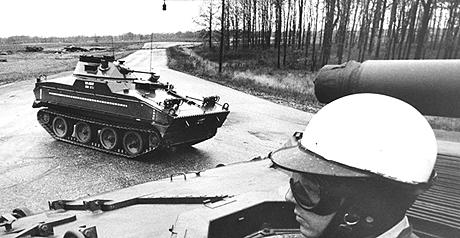 |
|
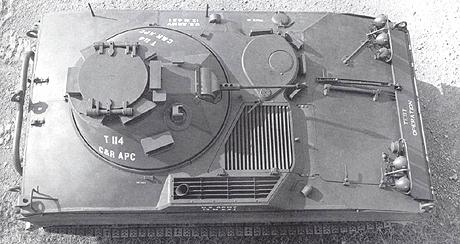
|
|
During the Army umpired evaluation of the final prototype, a T114
during road tests. Note the turret and upper hull configuration,
both were eliminated prior to production to control costs.
--Cleveland Press Archives |
|
Seen from above, the T114 with the M85 equipped machine gun
turret. --Hunnicutt |
|
|
|
|
Both Chrysler at Detroit Arsenal and Cadillac
Division of General Motors at the Cleveland Tank Plant expressed
interest, the former proposed diagrams bases on wheeled platforms, the
latter went with the "small-APC" format. Funding was initially granted
to pursue the designs from Cleveland and further funds for six
prototypes were allocated in 1957. The T114 program was well under
way. The light track concept had won the first round of the post war,
scout vehicle evolution.
The prototype scout vehicles delivered to the
Army for testing certainly had a "high tech" look and one can easily
visualize the concept drawings in Cleveland and Washington featuring
teams of T114s and T92 tanks prowling the nuclear battlefield. The
light tracked scout had a two man turret pushed to the rear of the
hull for the commander and observer; it was armed with the M85 .50
caliber machine-gun. Other manufactures were contacted for possible
turret variations and the Army specified that the final turret
decision was separate from approval of the general design of the
vehicle.
The automotive drive line of the T114 was
pulled to the front, engine to the right, driver to the left. The top
of the vehicle featured a rather complicated superstructure design
raising from a shallow raked front slope, however the overall height
of the vehicle remained low. The rear of the T114 had a large
rectangular hatch, the interior space, cramped for three troopers,
allowed for a jump seat and a possible fourth man. Many of the
automotive components were off the shelf GM items to include the 283
CI V8 gas engine and the Hydramatic transmission. This helped control
costs.
The tracks, developed by the Caterpillar
Corporation, were of the "rubber band" type, providing the supposed
advantages of lower costs, reduced weight and ease of maintenance in
comparison with a link track system. Manufactured as a single strip
with bolted in track pads and grousers, this development never lived
up to expectations. In an unsupported configuration on narrow road
wheels, the "rubber band" allowed for the small GM engine, this in
turn saved overall space and weight for the entire vehicle. In the
event of light damage from mines or direct fire, there was no plan for
a crew to repair broken track strips. In 1960, the Army began an
extensive series of tests at Aberdeen, Fort Knox and the Arctic Test
Center to evaluate the prototypes.
Cost Containment and Production
At the test centers and the production floor
at Cleveland Tank Plant, the T114 program was much anticipated as a
"winner". GM began serious planning for the assembly lines and hiring
began necessary to move the Cleveland plant towards full scale
production. In 1961, when the Army announced the required design
modifications resulting from the test phase, some significant changes
occurred, almost all of them designed to lower the cost per individual
vehicle. With so much time already invested in the program, the
designers went back to the blueprints.
|
|
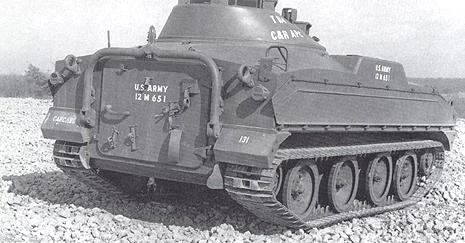 |
|
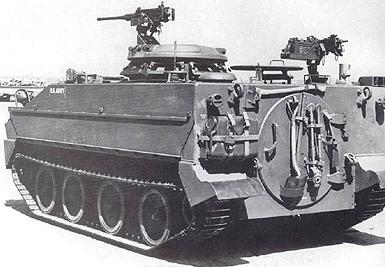 |
|
T114 seen from the ¾ view at rear. Note the rectangular rear hull
hatch. This feature was also eliminated at the end of the test
phase. --Hunnicutt |
|
M114 early model as issued to the scouts, note pedestal mounted M2
and .30 caliber machine guns, round rear hatch and greatly
simplified upper hull. --Hunnicutt |
|
|
|
|
The M85 armed two man turret was eliminated in
favor of a much more simple TC observation hatch-cupola arrangement;
this was moved forward of the previous location. The superstructure of
the hull top was greatly simplified into basically a flat piece of
aluminum, a small hatch was added to the rear of the TC hatch for the
observer and the large rear hull hatch was changed to a less costly
circular design. The armament was to consist of a pintle mounted M2
and a 30 caliber machine-gun for the TC and observer respectively. The
Army continued to look at other turrets that could be retrofitted
later and production funding was allocated to the budget when the new
design, based on the Army’s changes was approved.
As the modified blue prints went to
Washington, the first funds, 2.7 million dollars went to Cleveland to
begin plant modifications at Cadillac to accommodate M114 production
although the final contact had yet to be awarded. The plant had been
operating at about 20 % capacity manufacturing self propelled
howitzers and the Sheridan program was seen as still years away.
Politicians and union halls hailed the new jobs. A Cleveland Press
reported press release in July 1961 stated, " ... it (the M114) will
utilize a considerable number of aluminum parts to conserve weight for
airborne missions. It will carry infantry personnel and have special
weapons capability the details of which remain classified.". In
October of that year, the first large order was authorized with a
value of 15 million dollars. One third of this covered the costs of
the full scale assembly line, the balance paid for an initial run of
1215 vehicles.
|
|
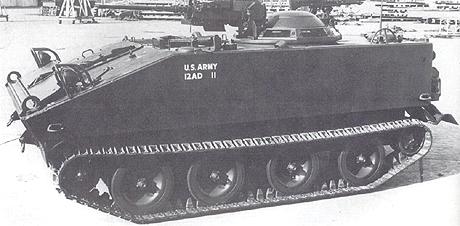 |
|
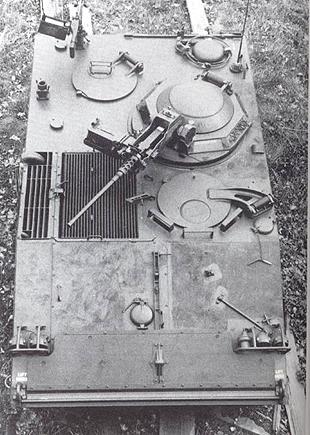 |
|
M114A1 featuring the M2 machine-gun in lowered cradle with new
cupola with sighting and internal traverse - elevation controls.
--Hunnicutt |
|
Same model, seen from above. --Hunnicutt |
|
|
|
|
I n August 1962, the assembly line was in full
operation with a single shift of over 3600 employees involved. On hand
as the first M114 was completed was Plant Manager Clifford D. Dernier,
BG Wheeler G. Merriam, Development chief of the Army Material Command
and several local politicians. Counting other contacts in force at the
Cadillac Plant, the Army had committed $ 99, 000, 000 to GM’s defense
efforts. One year later, the Army and GM officials visited the plant
again to hail the 1000th unit built, 200 more were programmed for
delivery that calendar year.
Production continued at full pace through the
following year then, in 1965, began to decrease as the Army expressed
no interest in further large scale orders. The lay offs began as
Chrysler won the contract to operate the plant and M114 production
line went to "slow mode" in anticipation of closing by the end of
1965. A total of 3710 copies were manufactured with an evolution of TC
turrets before M114 production ceased. Fielding appears to have begun
in 1962-1963 to the armored cavalry regiments and divisional
reconnaissance battalions / squadrons.
The Turrets
The pattern later seen with the selection of
the M551 gun system first can be traced to the turret and weapons
associated with the M114. The Army decided to not buy the two man
turret featuring the M85 machine-gun that had survived the design
conferences and prototype models as an austerity measure. However,
just as the Soviet PT 76, with it’s swim capability, had effectively
ended the T 92 program, as the M114 went into production, active
consideration and debate was under way as to how to arm the "armored
jeep" with consideration to the family of light but well armed Soviet
tanks and scout vehicles seen regularly on parade in Moscow.
The Soviet designers had fielded a wide
variety of both tracked and wheeled scout vehicles, many with both
troop carrying and fighting capabilities, that had virtually no NATO
counterparts. The heavy wheeled BTR 60 series, robust BRDM and BMP all
initially dated from this period. In the West, only the British seemed
interested in scout specific vehicles; as West Germany began their own
weapons production in the early 1960s, the first combat vehicles
approved were "heavy scout" platforms.
As the M114s progressed down the assembly
line, the first 600 or so featured the agreed upon pintle mounted M2
and 30 caliber machine-guns. A minor modification involved the
observer’s weapon as the M60 machine-gun entered the Army inventory,
the rear pintle mount changed on the M114. Then, at approximately
vehicle number 601, the turret was changed to accommodate a new sight
and manual traverse and elevation set of controls that would allow the
scout commander to engage targets with the M2 with all hatches closed.
This vehicle eventually was designated as the M114 A1 model.
Other turret and weapon configurations
continued to receive developmental funding and to give the scouts a
heavier weapon, a combination of the built under license- Italian
designed Hispano Suiza 20mm cannon with a powered turret, was funded,
approved for production and retro fitted to previously issued M114A1s.
This 20mm cannon had a long and unhappy life in the US Army; seemingly
every question at the Armor Board at Fort Knox could be answered in
the 1960s by saying, "... well ... lets add the 20mm cannon and see
what happens!". Both the M551 and the MBT 70 were evaluated with the
H-S cannon bolted to the turret top. It was only with the M114,
however, that the weapon actually reached the troops. Once configured
with a new powered cupola and cannon, the vehicle was designated as
the M114E2 if the original platform had been a low serial number M114
or, as the M114A1E1, if the platform had been first designated as an
M114A1.
|
|
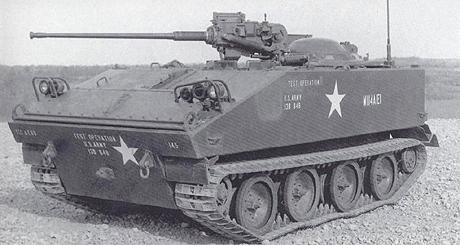
|
|
M114A1E1 featuring
the H - S 20mm cannon and powered turret, the final design
variant. The blank sheet scout vehicle was taking on a greater
combat role. --Hunnicutt |
| |
Hunnicutt, with a wealth of wonderful facts
and dates, does not discuss if any of the 20mm equipped M114s were
actually produced at the Cadillac Tank Plant or if the work was done
as either depot level rebuilds or by field modification teams.
Nevertheless, by 1964-1965, the MTO&E for a scout platoon specified
four M114s; operating in pairs, the 20mm cannon equipped vehicles
provided over watch for the M2 equipped vehicles. The platoon leader
was in a jeep or M114, he had an infantry squad and a 4.2 mortar in
their respective tracks and three M60 tanks. Through the 1960s and
well into the 1970s, cavalry, armor and infantry units saw different
vehicle mixes and totals depending on the MTO&E in use.
Telling the M114 story for the troopers
at Daley Barracks is a somewhat difficult task. We believe the first
copies were issued in 1963 with final turn - in ten or eleven years
later. Quite simply, not enough troopers from that period have stepped
forward with their recollections to adequately flesh out the story.
Many areas are unresolved, use of the vehicle on the border, gunnery
experiences at WTA and GTA to name just a few. Our only photos of the
M114 in service at Daley Barracks date from the mid 1960s. We hope
that this article stimulates memories and the desire to share them
among members of the 2 - 14 ACR.
As a substitute, MSG ( Ret ) Roy
Lingle, LTC ( Ret ) Burnis Allardyce share their recollections of the
M114 in the hands of troops. Roy served with a variety of armor and
cavalry units in the 1960s and 1970s with several experiences with the
M114. Burnis was at Fulda and Bad Hersfeld with the 14th ACR and first
days after the re - flag to the Blackhorse. We are convinced that
their recollections are comparable to what troopers in Bad Kissingen
experienced.
For a wonderful selection of photos
of the M114 in use at Bad Hersfeld, please
click here.
Making Due ...
Once in wide issue, the M114
exhibited several flaws apparently unnoticed in the design and testing
phases. While it was small, stealthy and quick on the roads and level
trails, in cross country operations and particularly in difficult
terrain, it was decidedly under powered. In later years, when weighed
down with the heavier 20mm cannon and ammunition, the marginal
performance decreased dramatically. The rubber band track required
very careful monitoring, was prone to spinning off the drive if track
tension was out of tolerance or simply break in standard operations.
Either way, if any speed was involved when track failure occurred, the
vehicle would wildly spin out of control. Likewise, the transmission
was prone to accidentally switch to "swim - low range" mode from
normal "drive" mode. If this happened at 25 mph, the vehicle would
violently buck and spin as if driven into a wall.
|
|
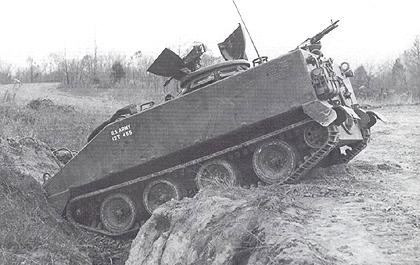 |
|
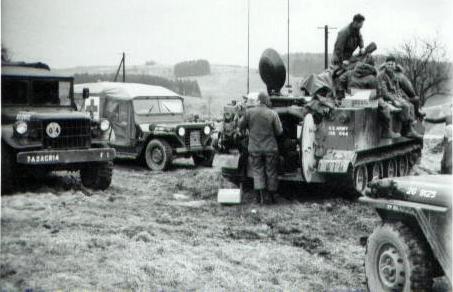 |
|
I've fallen and I can't get up!! Nosed into a ditch and stuck, the
protruding hull and under powered engine ends the day for this
scout track. Unable to drive through or back out, all they can do
is wait for the tow. --Hunnicutt |
|
Scouts of the 2/14 ACR on maneuver in Germany. --2/14th ACR |
|
|
|
|
A workable sleep schedule for a three
man crew created problems during FTXs, this was made all the worse if,
as was often the case in Germany during the Vietnam War, the crew was
short personnel. The 20mm cannon and powered turret worked if
maintained but proved to be maintenance headaches for all but the most
skilled turret mechanics. The recoil made rapid precision firing very
difficult. The nose of the M114 hull extended beyond the drive line of
the tracks, this caused the carrier to often "stick" at the bottom
ditch. As scouts began to acquire more equipment associated with their
missions, the limited carrying space in the hull became apparent.
Some 40 M114s were sent to Vietnam to
equip select ARVN units but the vehicle was deemed wholly unsuited to
the mission and environment and the experiment ended. For the Army in
Germany and the United States, gradually, fixes occurred to the track
and transmission problems. The chronic under power problems persisted
and of no use in Vietnam, funding for long term improvements was non
existent. The program began to "starve" in the final years as without
money or supporters, the M114 was tolerated until a interim
replacement could be found. By the mid 1970s, the vehicle was being
replaced by the reliable if uninspired M113 carrier as debate raged in
Washington and Fort Knox over just how to equip future armored cavalry
scouts. The M114 "blank sheet" scout specific vehicle had been, at
best, a marginal performer.
LTC (Ret) Burnis Allardyce
"I was a platoon leader in I Troop,
3rd Sqdn, 14th ACR in Bad Hersfeld during the first half of 1971. We
had 5 M114A1s in a cav platoon at that time. A year or so earlier the
M114s had been armed with a M2 cal 50 mg. Sometime in the year before
my arrival in the sqdn in July 1970, the M114s were upgunned with a
20mm H - S mounted in an electrical ring mount at the vehicle
commanders position. It was quite a improvement in firepower and
accuracy over what the sqdn previously had. People were still talking
about it when I left 2d platoon, M Troop and moved into a cav platoon
in I Troop."
|
|
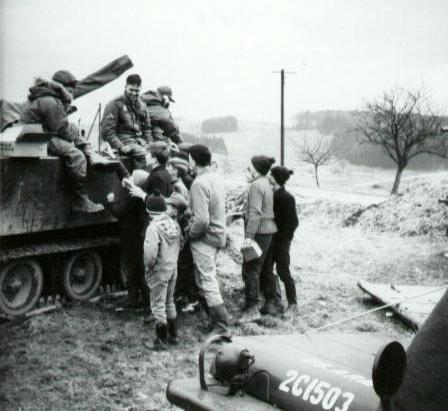 |
|
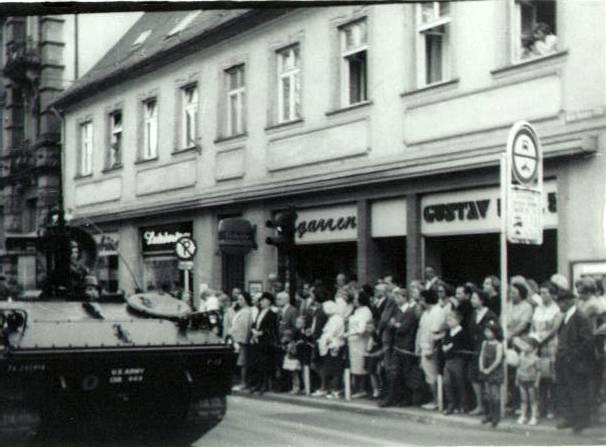 |
|
German kids
always fascinated by the American vehicles. --2/14th ACR |
|
On parade in Bad
Kissingen. --2/14th ACR |
|
|
|
|
"Later, as I Troop XO, I was involved
in the 3 x 5 exchange, which brought in the Sheridans. During this
period we lost the M60A1s and the M114A1 because it was thought that
the M551 could operate in both roles!"
"The M114A1 was a great little scout
vehicle in that it had low profile and a good 20mm gun; and if memory
serves me correctly, it was relatively quiet. The major problem with
this vehicle was that it was under powered and would easily stall when
loaded and climbing some of the steep inclines in the backwoods along
the IGB. Unfortunately, the 20mm gun and the added weight of it's
larger ammunition added to these problems and reduced the number of
rounds that we carried. If memory serves me right, I believe that the
gas engine for the M114 series vehicles was a General Motors (aka
Chevy) 283! I think that if it could have/would have been fitted with
a more powerful diesel engine, it could have made a good little scout
vehicle. That is what happened a few years earlier with the M113 when
it was upgraded from gas to a diesel engine. We still had some ‘gaser’
M113s in the 2nd Armored Division when I left Ft. Hood in December
1969."
"There was a lot of discussion in the
Armor community during this time regarding the role of scouts and how
they should be employed. There were a number of opinions, with the two
most diametrically opposed positions being either;
a) Scouts were supposed to be
stealthy, avoid contact with the enemy, but recon to determine the
enemy's position and disposition and report . . . . . .
to the opposite extreme . . . . . .
b) Scouts were to fight, delay and
determine the enemy's position and disposition without becoming
decisively engaged and report.
In the end ( b) won out."
"As I previously mentioned, each cav
platoon had 5 M114A-1s in its scout squad. The scout squad consisted
of 2 scout sections, each with 2 of these vehicles. The 5th vehicle
was TC'ed by the Scout Squad Leader. Dependent on the tactical
situation, the platoon leader, who was normally in one of the M60A-1s
in the armor section, might move into the scout squad leader's vehicle
and lead from there."
|
|
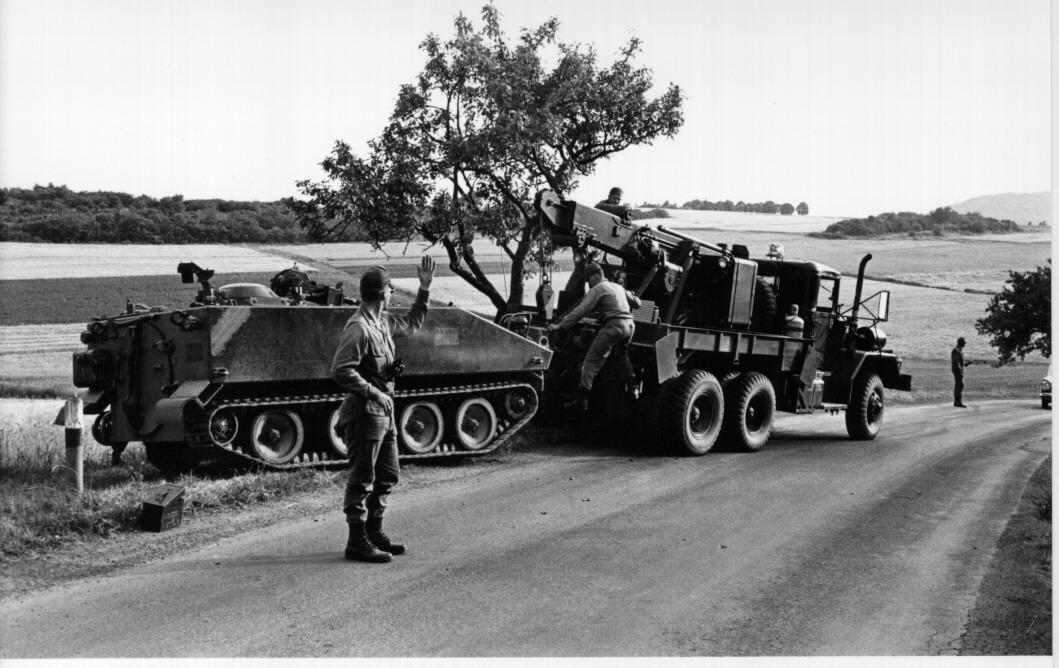 |
|
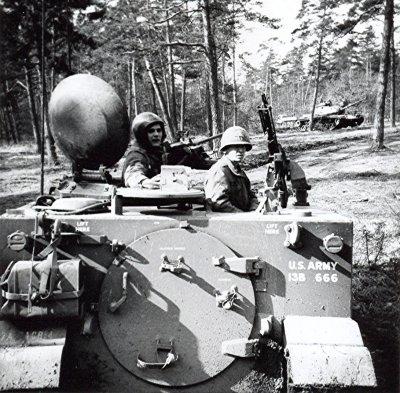 |
|
Recovery
operations after an M114 snaps its track and spins wildly into a
ditch. The TC was killed. --2/14th ACR |
|
"See ' ya guys!!"
Down the trail and soon, out of inventory, an M114 from the 2/14
ACR sets off for the day. In a few years, the scouts would be in
the reliable M113 and, not much later, the next blank sheet scout
vehicle was issued, the new M3 Scout Vehicle. From the armored
jeep to the tank killer, the evolution would be complete. --2/14th
ACR |
|
|
|
|
SFC (Ret) Roy Lingle
"I had a lot of experience with the
M114 family of vehicles, both good and bad, in Germany and USA. Here
is what I recall."
1st Bn (Light) / 63rd Armor at Ft.
Riley, Kansas.
"Those M-114A1s were not bad. They
ran good and we had great maintenance support. Moving cross country on
the grass covered plains of a Kansas prairie during the dry season was
easy. Since the battalion had M-551 Sheridans the battalion commander
tried to conduct a water crossing exercise ever time we went out on a
FTX. The M-114 was amphibious, but just barely. Due to the short
length of the vehicle and the front of the hull sticking out past the
sprockets most dry washes would stop us in our tracks. It was hard to
get down into many of them and sometimes impossible to get back out
without a tow from another vehicle."
"The Scout Platoon lost a TC one
night to a dry wash. The vehicle went over the edge in the dark and
flipped upside down. During the rainy season, the heavy Kansas mud
would put a very heavy strain on the power pack and it seems like we
lost a number of engines and transmissions during one late fall FTX
due to that mud."
4th Bn (Light)(Airborne)/68th Armor,
82nd Airborne Division at Ft. Ft. Bragg, North Carolina.
"Same group of vehicles and people,
name changed and relocation to Ft. Bragg. For the first few months the
vehicles did OK on the sandy roads running through the pine forests of
North Carolina. One time during driver training, I had a new driver
that didn't understand my instructions to "half-track" the tank trail
as we tried to climb a hill. Passed rains had made the ruts from other
tracked vehicles a bit deep. The new guy tired to follow the old ruts
and high centered the belly of the vehicle. We had fun digging the
sand out from under the hull so the tracks could move us back down the
hill."
"Sometime during late 1969 or 1970,
one of the mechanics sent in a suggestion for an improvement to the
sprocket system. He received a very nice 'thank you' but no thanks.
Good idea but the Army was planning on replacing the M-114 as soon as
possible and would not be funding any further upgrades to the vehicle.
In time, those vehicles started breaking down and it would take
forever to get something fixed. I had the feeling that the Army had
stopped buying spare parts for the M-114."
1st Bn (Mech) /30th Infantry
Division, Schweinfurt, FGR.
"In May 1974, I was assigned to
Schweinfurt. That unit had M-114A2s with the M-139 20 mm Hispano-Suiza
HS830 auto-cannon. That set of vehicles was in bad shape. At any one
time, I guess we may have had five or six of the nine moving under
their own power. Main problem was with mechanics that were not
trained on the engine, transmission or the steer gear and long delays
for replacement parts. Most field problems turned into broken vehicle
recovery training. We had major problems with the XM-27 hydraulic
powered turrets due to a lack of turret mechanics in the battalion. If
we could not fix a turret problem ourselves, it didn't get fixed. By
the time we turned those poor vehicles in during 1976, none of the
turrets had power."
"One of the best times I had was when
a new hard - charging platoon leader got the bright idea to fire those
20 mm cannons. It was a lot of work to get clearance for a range in
the Schweinfurt area to fire them and it didn't help that none of the
troopers in the platoon at that time, had ever live fired the cannon!
We had heard a number of rumors about problems and dangers and we were
not very comfortable with the first few rounds. The more we worked,
however, the more we liked it. For a Scout what was one amazing weapon
to fire! I had been told the AP-I round might go through the side of a
T-62 Soviet tank. I am very glad that I never had the chance to find
out. We also learned that the danger of a hang fire was related to the
type of warhead the round in the hot chamber had. If it was AP-I, no
problem, give it some time and if it cooked off, no problem. If it was
HE-I, big problem, it was possible for the warhead to cook off and
blow the chamber apart. You had to get that round out fast before it
had time to cook or clear the area and hope the vehicle didn't get
damaged."
"One other very interesting time was
when the battalion commander arranged for two vehicles to go with the
division Vulcan batteries for their annual live fire at the Germany
Army Todendort antiaircraft range on the Baltic Sea. We spent about
ten days there firing at slow, medium, and fast aerial target sleeves.
First day or so, we could not hit anything. We started with long
bursts (note: I think it was 20 or 25 rounds), dropped back to five
rounds short bursts and finally ending up using just single shots."
"The first problem was a bad case of
'rock and roll' ! The recoil from that cannon was too much for the
little seven ton M-114 to support. Trying to use long and shorts
bursts was a waste of ammo. The best we could do was get one hit on a
target sleeve per pass. All the other rounds either passed below or
over the target. We found a second problem when we tried the single
shot setting. We found that no one could see the tracers through the
Plexiglas sight with the speed rings for aerial targets. Between the
gas cloud at the end of the muzzle and the Plexiglas sight the gunner
could not see where he was firing. Then we tired using Kentucky
windage and found we all could get some hits. The trick was to stand
up behind the gun cradle and not try to look through the gun sights.
That way we could see the tracers and using BOT ( burst on target
adjustments ) move rounds onto the target sleeves. Using single shot,
the vehicle would almost stop rocking by the time we fired again. A
couple of the guys were getting three to five hits on the slow
targets, two or three on the mediums and one of two on the fast
targets by the time we were done."
"On the last day we found one more
problem. Back when we first started trying to use the cannons, we
learned that during training conditions it should be cleaned after
ever 550 rounds. For the last day, they wanted us to have three or
four hundred rounds left so one of the Assistance Division Commanders could
see us do our thing. On the day before, my vehicle only fired about
two hundred rounds before we reached the amount we had been told to
hold for the last day. I figured that we could get away with not
breaking the cannon down for cleaning that day. That was a MISTAKE!"
"By the next morning, that gun would
not work at all. It was glued together and the bolt would barely move.
Those cannons were gas operated and the gun powder residue built up
inside the receiver was very heavy. That residue mixed with lots of
LSA (oil for weapons) during the night turned into a glue. We had to
strip that receiver and do a very fast clean up job. That glue didn't
want to come off. Thinking about that event later, I wondered if a
Scout crew would have the time to take that weapon apart and clean it
so it wouldn't freeze up the next time it was needed if the Warsaw
Pact ever came through the Meiningen Gap?!"
"The H - S 20mm cannon may have been
a good weapon for a jet fighter plane, but I don't think it would have
worked very well down in the dirt of and mud that a Scout worked in.
It was hard to understand why the Army was still using the M-114 in
the mid and late 1970s. That was the vehicle we were going to use to
stop the Warsaw Pack and when asked what I would do if my vehicle
broke down, I would respond with ‘ the Warsaw Pact has plenty of
vehicles, I will just take one of theirs!’ I guess I was too young to
know better at the time. During 1976 we were very happy to turn those
poor vehicles in and pickup a set of new M113A1s. Now we could move
and keep on moving."
3rd Armored Cavalry Regiment at Ft.
Bliss, Texas
"In 1978, I was happy to go there
thinking I would be working with a real Cav unit again and it would be
different from scouting for a tank or infantry battalion. I was very
surprised to learn that the 3rd Cav was still using M-114A2s! In all
the 1st Squadron Cav platoons, the platoon leader and the two scout
squad leader vehicles in each platoon still had M-114A2s. The GSR
section also had two vehicles for a total of eleven per troop. As far
as I know, the 2nd and 3rd Squadrons also had the same set up. Running
around in the high desert of Ft. Bliss was a blast as long as the
vehicles ran. It was easier to hide, could slip between sand dunes
that other vehicles couldn't. The terrain, as long as it was dry,
wasn't that much of a problem. The main problem was replacement parts
and this was a nightmare. The Regiment had a sister National Guard
unit and every time a training team would go visit them, a number of
mechanics would tag along. That National Guard unit had just coveted
over to M-113s and M-60 MBTs. They were putting M114s that were in
better shape out on target ranges than the 3rd Cav was still trying to
use. Those mechanics would come back with completed power packs,
working steer gears, spare track sections, and endless other small
parts. Liberating parts form National Guard ranges to keep active Army
vehicles running!"
"During that time, the 3rd ACR was
part of the III Corps. One night an III Corps inspection team hit the
3rd ACR with a no notice deployment exercise. B Troop of the 1st
Squadron had the alert duty and started pulling everything together
and getting ready to move out. We counted heads, inventoried
everyone's duffel bags of all required items, moved everyone and all
equipment and weapons to the motor pool, fired up all the vehicles and
moved over to Biggs Army Airfield. That was new, the 3rd ACR had never
moved over to the airfield before."
"Next thing we saw, six Air Force
C-141s landing and pulling up near us. Surprise, Surprise! WE WERE
GOING SOMEWHERE! That somewhere turned out to be Holloman Air Force
base up in New Mexico which is about an hours drive by car from Ft.
Bliss. After assembling most of the troop there, we started a road
march through White Sands National Monument, White Sands Missile range
down into the Donna Anna ranges at the North end of Ft. Bliss. Out of
three Cav platoons with ten vehicle each, 29 made it to Holloman. My
M-114 lost the engine about two miles into the road march. After I had
reached the troop assembly area with two M-113s, each towing an M-114,
the troop put all operational vehicles on line and started a zone
recon mission."
"We crossed the LD with a total of
ten vehicles on line for a troop size mission. Out of eleven M-114A2s,
one GSR vehicle was still running. One vehicle was the 1st Sergeant's
M-151. There was one M-551A1 Sheridan and the other seven were M-113s.
When I left the 3rd ACE in the fall of 1979, the first train load of
M-60A1s to replace our old Sheridans had arrived. Rumors were that new
M-113A1s where on the way to replace the M-114s. The word at the time
was the 3rd ACR was the last unit in the total US Army still using the
M-114. The reason given was the 3rd ACR needed two of everything, one
item to use at Ft. Bliss and one for the war reserve stocks in
Germany."
"When the M-114 was working, I loved
that vehicle and thought I could be a good scout. Now days, while
thinking back, it was not a very good scout vehicle. It was too small
... try running fast enough to stay out in front of Sheridans or
Infantry APCs and it would beat you to a pulp. At top speed it
reminded me of the original mechanical bull ride. The tracks did not
stick out in front of the hull and it was too easy to bury the front
end into a small bank. One thing that I didn't notice during my time
with the first two units was the placement of the fuel cell. It was
next to the driver and over the first road wheel. After hitting a land
mine in Vietnam with a M-113A1 ACAV I felt that hitting a land mine
with the left front road wheel would most likely result in the driver
and TC getting burned to death if the mine didn't kill them outright."
"Firepower, that 20 mm auto cannon
was something else, but it was too much for the hull of the M-114.
Look at the Vulcan AAA version of the M-113. That hull had a
suspension lock out system to keep the hull for rocking while the M-61
Gatling gun is firing. There wasn't room in a M-114A2 hull for
something like that. I think that cannon would have only been good for
single shot sniping missions. Auto fire would have just been a waste
of ammo, something else that the hull didn't have a lot of room for. I
also think the tool kit needed to support that cannon was a possible
weak point. I forget the number of tools in that kit, but I remember
that when tearing down the receiver, you could get away with not using
one tool, but when it came to putting it all back together, you needed
each and ever tool. One lost or damaged tool and another scout vehicle
had better be close by."
"I guess the M114 vehicle was Ok but
I was amazed when the Army decided to stop supporting that vehicle
sometime during the late 1960s, long before it was finally replaced in
the active inventory in the end of the 1970s. It was very hard on my
morale and very difficult to explain to young scouts why we had such a
vehicle after hearing Commanders stand up in front of the unit and
tell us, we were the best, we had the best equipment, and we were the
point of the spear of the next war. I was glad I never had to go to
combat with that vehicle."
As late as 1979, the US Army was still
washing the M114 out of active inventory. The much anticipated Cavalry
Fighting Vehicle was in an endless design and test phase, the M113
would serve as the interim scout vehicle. With so many M114s produced,
where did they go?
|
|
|
|
|
|
|
|
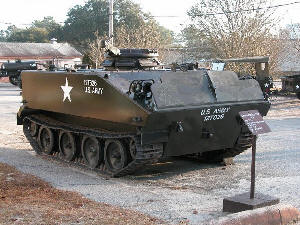 |
|
Not a few M114s
found their way into vehicle museums and onto hard-stands in front
of American Legion and VFW buildings. The vehicle shown here
has been fully restored and is currently on display at the Fort
Jackson, SC museum. Either click on the picture or
click here to view the other shots of this vehicle. [All
shots taken by Randy Mitchell] |
|
|
|
|
|
|
|
Very little remained of the M114
heritage at Daley Barracks in 1978, except for one often found motor
pool artifact. Seemingly every shop and tool truck had several 20mm
ammunition boxes recycled into general storage. They were just the
right size with convenient handles to live on as holders of "stuff".
Elsewhere, beyond the stories of my NCOs, an M114 lived on at the
small rec services ski slope at Wildflecken Post. It groomed the
slopes and provided snow - cat rescue and maintenance services,
probably the last runner in Germany. Stateside seemingly every CONUS
post had at least one on a concrete pedestal as a static display. At
Fort Polk, the M114 display was hidden away at the very far end of the
main avenue, tucked against the fence, no plaque, overgrown with
weeds.
At Fort Knox, as with the out of
inventory M551s, the M114 was recycled through many test versions, new
tracks, new engines, hull and weapon changes. Manufacturers would buff
a design up, fresh paint and a fresh concept, and run it before the
Armor Board. With passive interest, the comment, "... well, that’s
interesting ... what else do you have?".
Apparently some M114s were released
to Foreign Sales programs but perhaps its reputation preceded it and
the total number seems to be in the low 100s. As expected, the Reserve
and National Guard received their share, however, with Federal money
pulled out of the repair parts program, the service life of the
vehicle was destined to be short. However, once in the hands of the
states, many 114s found new life, minus the 20mm cannon, in police
blue, the ultimate crowd control toy - urban "attention getter . Many
others found their way to local scrap yards and, interestingly, into
the hands of private citizens.
The vast majority of
the M114s appear to have met their final fate down range as targets
for young US Army gunners. An odd scene on the firing line, tankers
and scouts ranging to that small target and taking the final sight
picture just as a Soviet gunner would have done. Not moving and
caught in the open, it did not take long to shoot up what remained of
the fleet.
BG (Ret) Mike O’Connell
"I recall having the final versions
of the M114 when I commanded the squadron at Daley and then we re -
flagged to the Blackhorse. They ran OK, I don't think we had
significant problems. My more vivid memory comes a few years later."
"As a Bde Cdr in the 1CAV Div, the
BDE + a Bn from the 2dAD + a beefed up DISCOM slice was deployed to
Fort Irwin from Aug to Dec 1976 . The purpose of this effort was to
conduct the initial test of the National Training Center concept. A
Congressman McKeown (?) from NY wanted to make Ft Drum the site for
the National Training Center while FORSCOM and the DA staff were set
on Ft Irwin."
"Before deciding on a final location
they wanted to test the concept. There was agreement on the basic need
but what should a BDE do while there on a rotation?? They also wanted
to test drawing equipment upon arrival - training with it and then
final turn in and all that associated stuff. In this case the tanks
were from the Calif NG. We deployed most of our other equip."
"We did an entire series of various
exercises from force on force ARTEPs to live fire PLT Battle Runs. The
hard targets we used for these battle runs and our other live fire
shoots were M114s. These were not just hulls but regular vehicles that
had been turned in and placed in storage somewhere. They had engines
in them, radios, tracks everything. I recall getting in a tank and
blasting the hell out of a couple of those 114s and was happy to do
so! After seeing what that old M60 did to a 114 I was glad I never had
to fight one of the damn things. I was hoping we would have had some
Sheridans to shoot at but no such luck."
M114 Reconsidered
Just how much saber and how much
stealth, wheels or tracks, small crew or large crew, tank killer or
sneak and peek? These are the questions debated through over forty
years of US Army scout vehicle development. The M114 was designed to
be an " armored jeep ", scouts would be more mobile and have greater
survivability in a small tracked vehicle. It could be bought on a
budget and, using off the shelf technology, operated and maintained by
a small crew. However, between the first mock up and the first
production copy, the program illustrates how compromises, a less than
rigorous testing program and "add- ons" can turn an interesting design
into a marginal performer. It now seems amazing that the hull-nose
issue and the engine performance problems were missed prior to
production.
A larger gas engine would have helped
solve the chronic power issues, the transmission, running gear issues,
and front hull design flaw should have been identified in pre-production testing. Somehow, none of this occurred. The power turret
and 20mm cannon, interesting developments in their own right, were not
a good match for the M114. Under the added weight, performance was
further decreased, the cannon was not a strong performer particularly
in rapid fire. In a fight, it could hold its own against Soviet lead
echelon scouts and infantry carriers, it could not kill a tank and
required a lot of crew maintenance. In Vietnam, that so dominated Army
thinking and procurement in the 1960s, the M114 had absolutely no
value.
Years later, as the M114 began to
wash out of the inventory and consideration was given to fresh
designs, civilians, bureaucrats and the active Army looked at hundreds
of concepts and mockups in a seemingly never ending first stage
competition to identify what would replace the M114 and M113 as the
Army’s scout vehicle. For a while, wheels were in vogue, then M113
variants, then blank sheet designs. Everyone knew the M113 was an
interim step to buy time but a major decision needed to be made.
Perhaps at Fort Knox, for the men who
would make the recommendations, senior grade officers, NCOs and civil
servants, coming to work every day past an M114 display on a concrete
pad served as a not too subtle reminder. Each day driving in and each
night driving home, one could not help but see and consider a concept,
design and production scout vehicle that had clearly not worked. The
first thought and the final thought of the duty day, "... we must
avoid making this mistake a second time ...".
The Army’s new scout vehicle would be
big, fast and lethal; there would be much more saber and much less
stealth. The legacy of the M114 is of good ideas gone bad and as a
silent reminder of what was to be avoided in the future. |
|